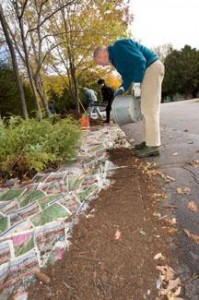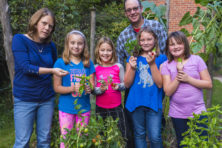How Does Your Garden Grow?
- Share
- Tweet
- Pin
- Share
Small Midwestern farms in the past were all about sustainability. Farmers tended milk cows, pigs and crops; wives were responsible for chickens and gardens. Because families produced much of what they ate, their grocery lists were short.
As the economy has become uncertain more people are planting gardens, some for the first time, and some are raising chickens as well. Serious gardeners find hens a natural complement to growing vegetables, as they provide manure for fertilizer and help control insect pests.
Iva Grasse, who has been gardening on the peninsula for 34 years, lives with her husband Jim on a 200-acre family farm near Ellison Bay. She remembers her venture into gardening.

Iva and Jim Grasse’s 200-acre family farm near Ellison Bay provides a perfect locale for a garden; however, don’t think you need to have an expansive plot to grow your own food. The Dickson family has been tending their 10-by-60-foot plot in the city of Sturgeon Bay for 12 years. Photo submitted by Iva Grasse.
“My first summer in Door County my sister-in-law got me started,” Grasse said. “She sat me down with a seed catalog. I was pretty green, and not my thumb! Everything I know I learned from her and my mother-in law.”
Jan Dickson and his wife Karen, who live on a residential lot in an older part of Sturgeon Bay with their children Ally (12) and James (9), grew up in gardening families. Since purchasing his home 12 years ago Dickson has been tending his own garden.
As country and city gardeners Grasse and Dickson have different horticultural situations, but they offer similar advice to novices who intend to become green-thumbers.
“Start small,” Dickson said, “and keep it simple. Don’t stress out over weeds.
“And your neighbors will appreciate your garden!” His family shares excess produce with their neighborhood.
Both Grasse and Dickson have always used the Jungs Seed Company catalog to order seeds. Headquartered in Randolph, Wis., Jungs for over 100 years has offered seeds and plant stock suited for the Midwest.

Back issues of the Peninsula Pulse were utilized in a “Lasagna Garden” at Woodcrest Condos in Ellison Bay in the fall of 2009. Feel free to re-use the Pulse (after you’ve read it, of course) for mulch in the garden, as they’re printed with soy ink.
Apart from the purchase of seeds, which Dickson estimates will cost about $15 for a simple garden of 400 square feet, start-up expenses will vary, depending upon whether or not the gardener needs to purchase tools and tilling services. Those who can borrow or barter will have a smaller investment.
While neither Dickson nor Grasse are certified organic gardeners, they endorse a number of techniques used by those who are. Both are believers in composting. Grasse maintains a compost pile of garden and kitchen waste (anything that she doesn’t feed to her chickens). Likewise, Dickson composts regularly, including grass clippings from neighbors; he points out that free compost is available from the city. He top dresses with his compost in the fall.
Composted vegetation not only provides essential nutrients for plants but builds soil as well. While Grasse applies compost to her four raised beds, she uses commercial fertilizer for her sweet corn in the “field” garden. “We plant a lot of corn!” she said.
Both gardeners use straw as mulch, applying it at the end of June after the soil has warmed and plants have begun to grow; the Grasse farm produces its own straw; Dickson purchases his from the Door County Co-op. Grasse learned from her mother-in-law to spread newspapers on the soil before adding a layer of straw; Dickson also likes that method of mulching. Not only is weed growth inhibited, but water is conserved. And by the end of the gardening season, the mulch has composted.
“The soil becomes soft like flour,” Grasse said.
She doesn’t water much at all, she continued, depending mostly upon rainfall and the mulch. Dickson uses a lawn sprinkler as necessary on his garden, which is a 10-by-60-foot plot.
Neither gardener likes commercial pesticides.
“We try to keep insects under control naturally,” Grasse said. “We mulch the edge of the garden to keep insects away and use natural remedies.”
Dickson uses environmentally friendly diatomaceous earth, a product with “the remains of algae, tiny glass shells that sticks in the bugs and kills them.”
Grasse uses an electric livestock fence to keep four-legged foragers at bay; Dickson uses an 18-inch chicken wire fence to keep rabbits out.
Both gardeners enjoy the fact that they save money on groceries. UW-Extension Nutritionist Coordinator Jenny Spude recalled a Burpee Seed Company study that found an average family of four with a 400 square foot garden could save as much as $2,500 a year on their food bill.
In addition to enjoying fresh produce, Grasse and Dickson can and freeze vegetables, and make pickles. However, both gardeners believe the most important returns are not monetary.
“You know you are growing something yourself,” Grasse said. “You feel good about this. You know it’s natural food you’re growing for your family, and you see your little grandchildren eating from your garden!”
“We like the fresh food,” Dickson said, “and we want our kids to know where food comes from. Now we garden because my kids like to!”
Advice for Gardeners
Ask questions of seasoned gardeners; like grandparents fielding inquiries about their grandchildren, they will be willing to tell you as much as you want to know! Check out books at your local library, or visit the UW-Extension Door County Web site at http://www.uwex.edu/ces/cty/door.
Plotting Your Garden
Alternatives exist for those who do not own garden space. Emerson, we remember, allowed Thoreau to use land at Walden Pond for his planting; you might make similar arrangements with a friend.
Jenny Spude and Jenny Fischer are planning a community garden in Sturgeon Bay; watch for notices as the project develops.
Some gardeners grow vegetables in containers or add ornamental edibles to flowerbeds. A sunny spot, of course, is essential whatever option you choose.
Recommended Vegetables
Some gardeners prefer heirloom varieties and others like modern hybrids. Grasse and Dickson recommend the following vegetables for a first-time gardener:
• Green beans
• Onions (sets)
• Tomatoes (plants)
• Radishes
• Lettuces (mixture)
• Carrots
• Beets
• Swiss chard (rather than spinach)
• Zuchinni
• Cabbages (plants)
• Cucumbers
• Peas
• Broccoli (plants)
• Peppers (plants)
• Dill
• Cilantro
• Basil
If space is not an issue, consider squash and pumpkins planted
among rows of corn or along the edges of your garden.
Starting Your Own Seeds
Tomatoes, cabbages, broccoli and basil may all be successfully started from seed in a sunny window, following the recommended planting date on the packages. Purchase soil formulated for germinating seeds and keep it moist for the seeds to sprout and thrive.
Summer Soup
Brown a beef shank and simmer it in 3 or 4 quarts of water with ½ cup of chopped green onions, one chopped carrot and a bouquet garni of fresh herbs for 2 hours. Then add 4 cups of assorted sliced vegetables from your garden and simmer for another 45 minutes. Season to taste.
Note: As your goal should be to use as many fresh vegetables as possible, the character of your soup will evolve as the summer progresses. Root vegetables will give your soup a natural sweetness, and greens will create a tasty “pot liquor.” Vegetarians may replace the beef shank with 3 cups of chopped fresh vegetables for the stock and then after 2 hours, add the remaining 4 cups of sliced vegetables.
Planting Timeline
In general the growing season will be earlier on the bayside than the lakeside, and lower on the peninsula than at the tip. In addition, gardens might be located in micro-climates offering yet another variable. If uncertain, be conservative with your planting schedule; vegetables tend to catch up as the season warms!
Onion sets, radishes, lettuces, carrots, beets, swiss chard, peas, dill and cilantro can be planted once the soil is tillable and has begun to warm, usually around the first of May. Once cabbage and broccoli plants have been gradually accustomed to cool weather, they may be set out at this time also.
Other vegetables on the list must wait until all dangers of frost have passed, traditionally by Memorial Day. However, corn does not germinate with cold feet and often prefers to wait until the end of the first week in June.


